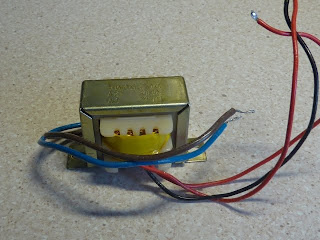I’m sure you know how it is. I’m sure you’ve been there. You’ve had an idea and – despite all indications to the contrary, despite KNOWING it is a foolish scheme – you just can’t stop yourself. So it is with me…
Guess it started with talking to Ian g3roo at Rishworth and watching him operate his B2. It wasn’t helped by talking to Johnny sm7ucz and drooling over his beautiful work on (another) replica Paraset. Things got serious when I joined the B2Spy yahoo group and saw photos and schematics of the B2. It got much worse last week when I started chatting with Dom, m1kta, and even downloaded some schematics.
It wasn’t that intended to build a B2 – no – I have enough instinct for self-preservation left to avoid that! I am, however, inexorably drawn towards another VALVE PROJECT!*?*!*! Like a beginner on a ski slope, I’m slipping towards the madness and inconvenience of those charming anachronisms – tubes!
Sure, I’ve built a
replica Paraset (indeed, seeing Ian’s B2 has prompted me to have a few more QSOs on my Paraset). Sure, I have a nice collection of valve audio power amplifiers (including the inevitable Quads and – my personal favourite – the Beam Echo / Avantic DL7-35s). Sure, I run an old Fender Pro Reverb amplifier for my guitars and Fender-Rhodes piano. But – to be honest – I’m not really on home turf with tubes. Despite being a classmate of
Morgan Jones for a while, I’ve only ever dabbled. So, now, it is time to really get my feet wet…
Whilst toying with the idea of (NOT) building a B2, I asked myself what it was about that foolish notion that really interested me. I realized quickly that it is the idea of playing with the
receiver side, rather than the transmitter (the B2 has a much more sophisticated Rx than the Paraset). So, rather than condemn myself to the task of building a B2 Rx, I looked around for something more practical that would satisfy my cravings…
Harry Lythall, sm0vpo, has a nice design for an "Old School" General Coverage receiver that would suit my needs – most obviously by being valve-based. Also, importantly, it is a superhet.
As well as being a bit of a tyro with valves, I have absolutely no practical experience of superhets. Sure, I own some old radios which are superhets, including an AR88 to which I moor my GP14 dinghy (HI HI). However, all my HB efforts to date have been direct conversion devices (discounting the perverse goings on inside the computer in my SDR radios). It is time to enter the murky world of IF transformers (I can’t wait to make a “Wobbulator”) and Harry’s design looks like a good learning opportunity. I made the first steps this afternoon…
Starting with the AF stage, I hit on an immediate problem – the output transformer. I’m going to follow Harry’s advice and use a little mains transformer, having one on hand (which I got from Maplin, along with its smaller cousin – the smaller cousin is seeing service as the AF output choke in my Paraset and the donor transformer in question (seen below) was lying around in a junk box, not realizing it was about to be transformed into an AF output device).

Harry explains how it is desirable to strip down the transformer to break open the magnetic circuit, in order to avoid the d.c. current through the primary (the anode current) saturating the transformer. I stripped down the donor transformer – you can see immediately why the core laminations are called “E” and “I”.

Harry counsels using a cheap transformer, in which the laminations won’t be lacquered together. Unfortunately (and totally out-of-character) I had paid way too much money for mine and so disassembly involved a Stanley knife. Anybody foolish enough to follow me down this path will have ample opportunity for cutting themselves as preparation for the nasty HT shocks to follow HI HI. You can see the donor device stripped down to component parts below…

Putting all the “E”s into the “coil” from one side is easy and what will be the top of the frame (once the device is the right way up) holds the “I”s in place while you get ready for the next stage.

The Es and Is are isolated by what Harry calls a “thin sheet of typing paper” – you can see my paper in the frame in the picture below. Also, I’ve put some insulating tape around the Es to guard against mechanical rattles.

The re-assembled device is seen here…

I even left the QC sticker on – just in case I need to take it back to Maplin’s!

Now let’s see what this puppy does…
The aim is to use an ordinary loudspeaker, with its low impedance, as the anode load in a common-cathode valve stage. To do this, the transformer must transform the impedance of the speaker to a much higher value.
I measured the impedance, looking into the primary of the new transformer, with the loudspeaker loading the secondary. The set-up was just a power amplifier driving the transformer in series with a 100 Ohm resistor. I could measure the voltage over the transformer primary and the voltage over the resistor (and so calculate the [magnitude of the] impedance).

The measured impedance is shown in the graph – three traces are visible; one for the loudspeaker driver directly, one for the loudspeaker connected over all the (center-tapped) secondary and one for the loudspeaker connected over half the secondary.

The loudspeaker alone shows the expected 8 Ohm nominal impedance, a peak at its mechanical resonance and the beginnings of a lift due to coil inductance at high frequency. The transformer coupled impedances are much higher – but the resonance peak of the loudspeaker is still visible in both cases.
I seem to have here the beginnings of a viable output coupling transformer for the AF stage – I’ll let you know how I get on with it!
…-.- de m0xpd




















